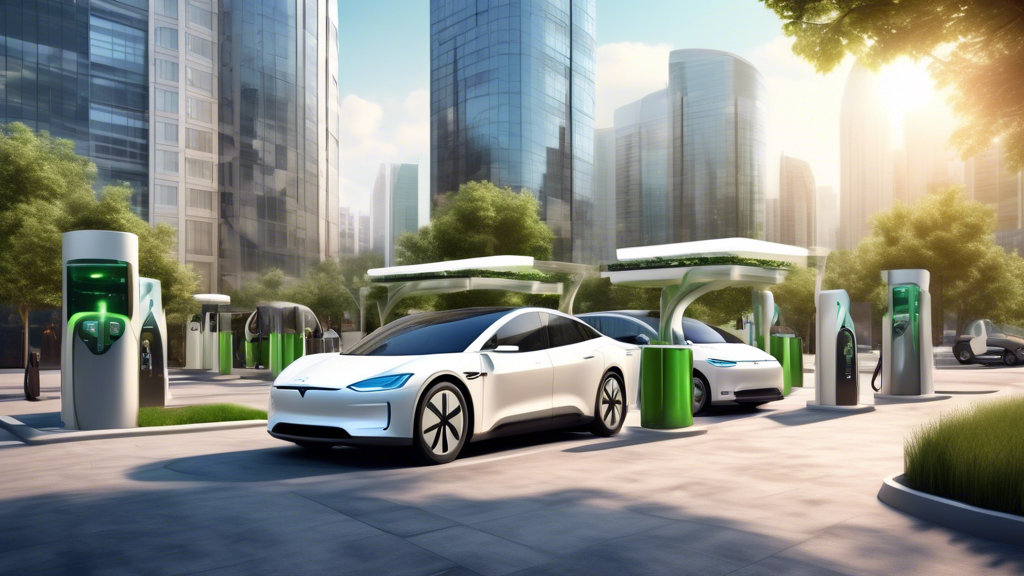
Imagine driving your electric vehicle (EV) across town without worrying about running out of juice. Sound appealing? That’s the future we’re moving towards, thanks to the rise of EV charging stations. With the growing popularity of electric vehicles, the demand for accessible and efficient charging solutions has skyrocketed. But how did we get here, and why does it matter?
The Evolution and Growth of EV Charging Stations
First, let’s take a trip down memory lane. Remember when spotting an electric car on the road was as rare as finding a needle in a haystack? Times have changed. The EV market has seen a massive surge, driven by technological advancements and growing environmental awareness.
In the early days, EV charging infrastructure was limited and often unreliable. Early adopters had to plan their journeys meticulously, often lamenting the scarcity of charging points. However, the charging landscape began evolving rapidly. Key milestones, such as introducing fast-charging stations and developing universal charging connectors, played crucial roles in this transformation.
The Evolution and Growth of EV Charging Stations
Overview of the Electric Vehicle (EV) Market Surge
The world is seeing a significant shift towards electric vehicles (EVs). Why, you ask? Well, for starters, EVs are becoming more affordable. This surge results from manufacturers finally cracking the code to make electric technology efficient and cost-effective. Governments worldwide are also stepping in, offering incentives and subsidies. All these factors and a growing public awareness of environmental issues are pushing more drivers to go electric.
The demand for EVs continues to skyrocket. By 2030, experts predict that electric vehicles will make up over 30% of all cars on the road. This growing market isn’t just a trend; it’s here to stay. With more EVs zooming around, places urgently need to charge them (no one wants to be stranded with a dead battery!).
Historical Context and Development of EV Charging Infrastructure
Let’s take a quick trip down memory lane. The first electric vehicle dates back to the 19th century, but modern EVs took over a century to reach the mainstream. Initially, charging infrastructure was almost non-existent, and early adopters faced significant challenges in finding places to charge their shiny new rides.
Fast forward to the late 2000s, and things started to change. Governments and private companies began investing in EV charging stations. Initially, these were mostly slow chargers placed in urban areas. But hey, it was a start! Slowly but surely, the infrastructure began to expand.
Key Milestones and Advancements in Charging Technology
Jumping past the boring bits, let’s look at some game-changing milestones. 2012 Tesla introduced the Supercharger network, making long-distance EV travel feasible. This was huge! You could now take road trips without worrying about running out of juice in nowhere.
Advancements didn’t stop there. Charging technology kept evolving, and we witnessed the birth of fast chargers capable of filling up an EV battery in under an hour. Now we’re talking! These fast chargers began popping up at strategic locations such as highways, shopping centers, and workplaces.
Another leap forward came with the development of ultra-fast chargers. These chargers can provide up to 300 miles of range in just 15 minutes. Imagine that! Grab a coffee, and you’re good to go. As charging speeds increased, the range anxiety (the fear of running out of battery) that plagued many potential EV buyers started to fade.
Oh, and did we mention wireless charging? It’s not mainstream yet, but it’s on the horizon. Soon, you might not even need to plug your car in. Just park over a charging pad, and your car charges automatically. The future seems pretty cool, right?
While we’re at it, let’s not forget about the smart grid technology. Smart grids can manage energy distribution more efficiently, ensuring EV charging doesn’t overwhelm the power grid. They can also integrate renewable energy sources, making the entire system more sustainable. Now, that’s some smart thinking!
These technological advancements and historical milestones have paved the way for the rapid expansion of EV charging stations today. From its humble beginnings to today’s high-tech solutions, the evolution of EV charging infrastructure has been remarkable.
So, there you have it. The growth of EV charging stations has been fueled by rising demand, strategic investments, and groundbreaking technological advancements. It’s an exciting time to be part of this revolution, whether you’re an EV owner or just a fan of cleaner, greener transportation.
Key Benefits of Expanding EV Charging Stations
Environmental Advantages: Reducing Carbon Emissions and Air Pollution
The buzz around electric vehicles isn’t just about sleek designs or advanced technology. One of the most compelling benefits of EVs is their role in combating climate change. Traditional gasoline-powered vehicles contribute significantly to carbon emissions and air pollution. EVs, on the other hand, offer a cleaner alternative. But let’s not kid ourselves—switching to EVs alone won’t save the planet. We need a robust network of EV charging stations to support widespread adoption.
Imagine a world with fewer tailpipe emissions and cleaner air. It’s not far-fetched. EV charging stations play a key role in enabling this vision. They support transitioning from fossil fuels to renewable energy sources, significantly curbing greenhouse gas emissions and promoting a healthier environment. Fewer emissions translate to less smog and lower incidences of respiratory ailments. Sounds like a breath of fresh air, doesn’t it?
Economic Impact: Job Creation and Investment Opportunities
Beyond environmental perks, the expansion of EV charging stations offers substantial economic benefits. Let’s talk jobs. The growth of the EV market translates into numerous job opportunities, from installing and maintaining charging stations to manufacturing EV components. These aren’t just short-term gigs—they’re stable, long-term roles that employ across various sectors.
Think about the ripple effect. More stations mean more technicians, construction workers, engineers, and support staff. And that’s not where it ends. The broader economy benefits, too, with increased demand for materials and services fueling local businesses. Plus, investment in EV infrastructure attracts venture capital and incentivizes innovation, ultimately leading to a more dynamic and resilient economy. Who knew that plugging in your car could charge up the job market?
Enhanced Convenience and Accessibility for EV Users
Ever experienced range anxiety? It’s that nagging fear that your EV might run out of juice before you find a charging station. Expanding EV charging infrastructure can put those worries to rest. More charging stations mean EV users can enjoy greater freedom and flexibility without constantly eyeing the battery gauge.
Imagine hitting the open road for a spontaneous trip, knowing that a charging station is always within reach. Enhanced convenience and accessibility make the switch to EVs even more appealing. No more detours or frantic Google searches for the nearest station. It’s all about peace of mind and seamless EV ownership.
Furthermore, expanded charging infrastructure supports the growing EV community. It’s not just about having more stations; it’s also about strategically placing them where users need them most. Think shopping centers, workplaces, and residential areas. Convenient charging options encourage more people to take the plunge and switch to electric. So, if you’re on the fence about getting an EV, wider access to charging stations might just tip the scales in favor of making that leap.
Future Trends and Challenges for EV Charging Stations
Emerging Technologies in the EV Charging Landscape
Imagine pulling up to a charging station and juicing your EV in minutes. Sounds like science fiction, right? Well, ultra-fast chargers are turning that into a reality. These chargers can significantly reduce charging times, bringing convenience to a new level.
And it doesn’t stop there. Wireless charging is another game-changer. Forget about plugging in your vehicle. You could just park over a charging pad, and voilà, your EV starts charging. This technology, still in its early stages, promises to revolutionize the ease of charge for EV drivers. It’s like your phone’s wireless charger but scaled up for an entire car. Pretty neat, huh?
Infrastructure Challenges: Ensuring Widespread Availability and Grid Capacity
Sorcery-level chargers aside, expanding the EV charging network is no walk in the park. Ensuring widespread availability of charging stations is crucial. After all, what’s the point of having an EV if you can’t find a place to charge it? Think of it like having a smartphone without Wi-Fi anywhere. It just doesn’t work!
Grid capacity poses another significant challenge. More EVs on the road mean a higher electricity demand. Picture everyone plugging in their EVs after work. The power grid needs to handle that massive load without going haywire. This will call for smart grid solutions to manage demand spikes and avoid blackouts.
Another thing to keep in mind is the integration of renewable energy sources. Combining EV charging stations with solar or wind power seems like the perfect marriage as we aim to reduce our carbon footprints. But it’s easier said than done, requiring significant investment and innovation.
Government Policies and Incentives Driving the Adoption of EV Charging Stations
The importance of government policies in this arena cannot be overstated. Policies and incentives play a massive role in driving the adoption of EV charging stations. Isn’t it nice when you get incentives to do something good? Like, here’s a tax break for setting up an EV station! Yes, please!
Many countries offer financial incentives to businesses and individuals installing EV chargers. These can be tax credits, rebates, or even grants. These incentives make it financially feasible and accelerate the pace of infrastructure development.
Additionally, governments are setting up ambitious plans for zero-emission zones and higher carbon emission standards. Picture entire cities where only EVs can roam freely. This pushes the market towards an EV-dominant future, making charging stations as common as your favorite coffee shop.
So what does all this mean for you? If you’re considering an EV, the future looks promising, with faster, more convenient charging options right around the corner. And businesses have a golden opportunity to invest in this burgeoning sector. It’s an exciting time to be part of this electrifying journey!
In Conclusion
It’s clear that the growth of EV charging stations isn’t just a trend; it’s reshaping our world. We’ve seen how historical strides, technological advancements, and policy influences have driven this change. With each new charging station, we’re steering away from carbon emissions and gearing towards a greener planet.
Moreover, the economic ripple effects—job creation and fresh investment opportunities—are undeniable. It’s like winning a sustainability lottery, but everyone’s a winner. And let’s not forget the sheer convenience it brings to EV users, making long journeys less about “range anxiety” and more about planning the next adventure.
Looking ahead, the EV charging stations’ landscape appears promising and challenging. Emerging technologies like wireless and ultra-fast chargers will redefine our recharging habits. Yet, the infrastructure must evolve to support these advancements and ensure universal accessibility.
Governments have a crucial role here. With the right policies and incentives, they can turbocharge the adoption of EV charging stations. It’s a classic case of ‘if you build it, they will come’—but only if you’re willing to adapt to future trends and tackle the challenges head-on.
The road ahead for EV charging stations is dynamic and transformative, beckoning us towards a future that’s not only sustainable but also thrillingly innovative. Are you ready to plug into the future?
